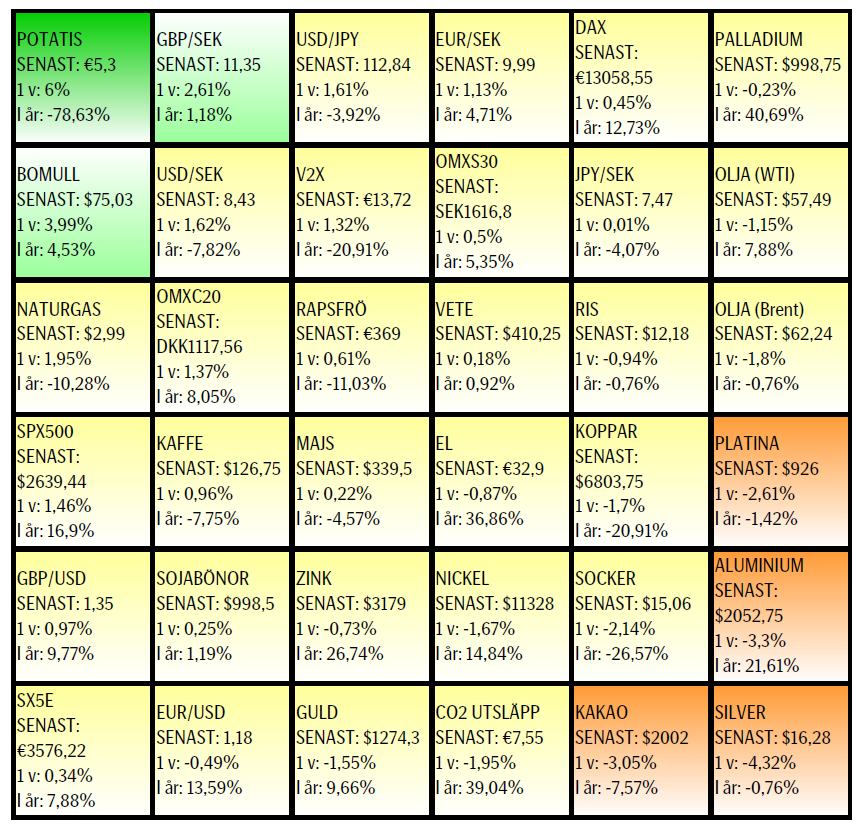Analys
SEB Råvarubrev 5 december 2017

 Råvaror: Beskedet om att OPEC/icke OPEC redan nu bestämt sig för att förlänga innevarande produktionsbegränsningar mottogs inte med några större kursrörelser i oljepriset. I princip kan man nog säga att de förlängda begränsningarna fick tummen upp av innehavarna av långa terminskontrakt då nära nog ingen vinsthemtagning noterats. Det är också intressant hur samarbetet mellan Ryssland och Saudiarabien utvecklats och förstärkts vilket ger ytterligare tyngd till överenskommelsen. Det finns dock starka krafter i Ryssland (där ju oljeindustrin till skillnad mot Saudiarabien inte är statlig) för att öka produktionen. Kanske kontrollpunkten i juni kan vara ett tillfälle för Ryssland och övriga icke OPEC att hoppa av? En sådan utveckling skulle också göra att den olja som så småningom ska tillbaka till marknaden kan gör så än mer gradvis. Basmetallerna har fortsatt korrektionerna nedåt ledda av nickel och aluminium som också gav negativa månadssignaler. Kinesiskt stål har stigit kraftigt och nått nivåer vi inte sett på cirka tio år. Ädelmetaller fortsätter att befinna sig i bakvattnet. CO2 glider nedåt.
Råvaror: Beskedet om att OPEC/icke OPEC redan nu bestämt sig för att förlänga innevarande produktionsbegränsningar mottogs inte med några större kursrörelser i oljepriset. I princip kan man nog säga att de förlängda begränsningarna fick tummen upp av innehavarna av långa terminskontrakt då nära nog ingen vinsthemtagning noterats. Det är också intressant hur samarbetet mellan Ryssland och Saudiarabien utvecklats och förstärkts vilket ger ytterligare tyngd till överenskommelsen. Det finns dock starka krafter i Ryssland (där ju oljeindustrin till skillnad mot Saudiarabien inte är statlig) för att öka produktionen. Kanske kontrollpunkten i juni kan vara ett tillfälle för Ryssland och övriga icke OPEC att hoppa av? En sådan utveckling skulle också göra att den olja som så småningom ska tillbaka till marknaden kan gör så än mer gradvis. Basmetallerna har fortsatt korrektionerna nedåt ledda av nickel och aluminium som också gav negativa månadssignaler. Kinesiskt stål har stigit kraftigt och nått nivåer vi inte sett på cirka tio år. Ädelmetaller fortsätter att befinna sig i bakvattnet. CO2 glider nedåt.
Valuta: Dollarn har, understödd av en amerikansk skatteöverenskommelse och en kommande räntehöjning, fortsatt att ta tillbaka tidigare förlorad mark. Rörelsen är särskilt märkbar i USD/SEK då vi fått både en starkare dollar men också en allt svagare krona givet den allt oroligare bostadsmarknaden samt kommande PPM flöden, där en majoritet placeras i utländska fonder (= kronförsäljningar).
En placering i certifikat och warranter är förknippat med risker. Du kan förlora hela ditt investerade kapital. Läs mer om riskerna i SEB:s offentliggjorda Grundprospekt för certifikat- och warrantprogram på seb.se/cert eller seb.se/mini
OLJA BRENT
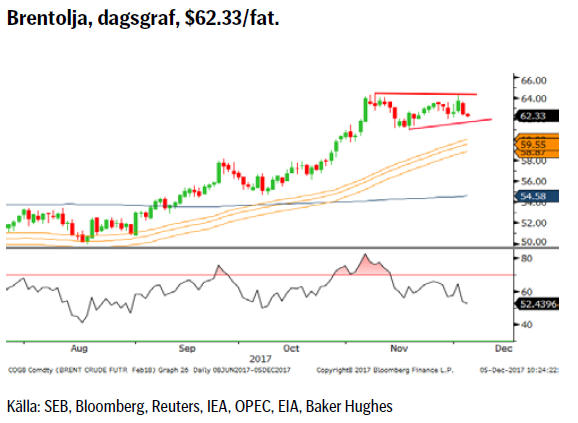 Lite överraskande, i alla fall för oss, att OPEC/icke OPEC redan vid förra veckans möte beslutade om en förlängning av innevarande produktionsbegränsningar från 31/3 till 31/12 2018. Dessutom klargjorde man att när överenskommelsen upphör kommer man inte att tillåta att de globala lagren ökar dvs. de kommer att skruva på kranen i lämplig takt. Dessutom lägger man in en kontrollpunkt vid mötet i juni. Beskedet bör ta bort en del nedåtrisk då framför allt Saudiarabien deklarerade att det inte kommer att bli fråga om ett plötsligt ökat utbud av 1,8m fpd utan en gradvis och övervakad produktionsökning. Saudierna har ju också allt intresse av att hålla priset uppe inför börsnoteringen av 5 % av Aramco (~100 miljarder USD). Det återstår dock nu att se hur de amerikanska skifferproducenterna tar in beskedet om förlängningen. Tillfrågade säger tre av de större fristående aktörerna att de inte har någon plan på att kraftigt öka antalet borriggar.
Lite överraskande, i alla fall för oss, att OPEC/icke OPEC redan vid förra veckans möte beslutade om en förlängning av innevarande produktionsbegränsningar från 31/3 till 31/12 2018. Dessutom klargjorde man att när överenskommelsen upphör kommer man inte att tillåta att de globala lagren ökar dvs. de kommer att skruva på kranen i lämplig takt. Dessutom lägger man in en kontrollpunkt vid mötet i juni. Beskedet bör ta bort en del nedåtrisk då framför allt Saudiarabien deklarerade att det inte kommer att bli fråga om ett plötsligt ökat utbud av 1,8m fpd utan en gradvis och övervakad produktionsökning. Saudierna har ju också allt intresse av att hålla priset uppe inför börsnoteringen av 5 % av Aramco (~100 miljarder USD). Det återstår dock nu att se hur de amerikanska skifferproducenterna tar in beskedet om förlängningen. Tillfrågade säger tre av de större fristående aktörerna att de inte har någon plan på att kraftigt öka antalet borriggar.
Konklusion: Positiv konsolidering efter OPEC’s besked.
OBSERVATIONER
+ Att OPEC redan nu förlängde produktionsbegränsningarna.
+ Att förlängningen nu också omfattar Libyen och Nigeria.
+ OPEC’s besked om exitstrategi, att gradvis öka produktionen.
+ Geopolitikens återkomst
+ Dollarkorrektionen har tappat fart.
+ Kurvans negativa lutning (backwardation) då det lättare att ligga lång.
+ Långa spekulativa nettopositioner är mycket stora.
+ Både IEA och OPEC har nu uppgraderat prognoserna för efterfrågan på olja (OPEC ser nu ett underskott 20185).
+ Situationen i Venezuela är kaotisk.
+ Tekniskt ligger vi i en positiv konsolidering.
– Nettopositioneringen är väldigt stor = framtida utbud.
– Om den geopolitiska situationen lugnar sig.
– EIA och OPEC justerar upp am. skifferoljeproduktion för 2018.
– Antalet borrade men inte igångsatta oljebrunnar, s.k. DUC’s (Drilled but UnCompleted) bara ökar.
Tillgängliga certifikat:
BULL OLJA X1, X2, X4, X5, & X10 S
BEAR OLJA X1, X2, X4, X5 & X10 S
ALUMINIUM
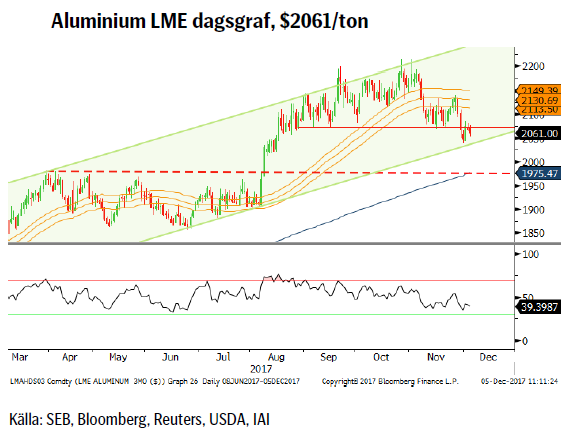 Så har då korrektionen nått ett förstahandsmål, golvet i den stigande kanalen. Givet att vi nu är inne i den period av året (15/11- 15/3) där kinesiska myndigheter i år för första gången kan tvinga fram stängningar i de fyra provinser med största luftföroreningsproblemen bör göra att nedsidan nu bör vara något begränsad. Effekten av de tidigare nedslagen på ”illegal” produktion börjar nu synas i statistiken då kinesisk produktion under september minskade med 6,6 %. Dock bör man betänka att nedstängningar av produktion inte är någon snabb och billig åtgärd varför myndigheterna sannolikt kommer att vara rätt restriktiva med dessa åtgärder.
Så har då korrektionen nått ett förstahandsmål, golvet i den stigande kanalen. Givet att vi nu är inne i den period av året (15/11- 15/3) där kinesiska myndigheter i år för första gången kan tvinga fram stängningar i de fyra provinser med största luftföroreningsproblemen bör göra att nedsidan nu bör vara något begränsad. Effekten av de tidigare nedslagen på ”illegal” produktion börjar nu synas i statistiken då kinesisk produktion under september minskade med 6,6 %. Dock bör man betänka att nedstängningar av produktion inte är någon snabb och billig åtgärd varför myndigheterna sannolikt kommer att vara rätt restriktiva med dessa åtgärder.
Konklusion: Än så länge kvar i den stigande kanalen.
OBSERVATIONER
+ Ökad risk för att brist på el (kol) och aluminiumoxid pga. miljömässiga neddragningar pressar upp priset på alu.
+ Signaler om lägre utbyggnadplaner för 2018 än 2017.
+ Positiv dollarreaktion på skatteuppgörelsen.
+ Global efterfrågeökning är fortsatt stark (troligen den starkaste av de vanliga basmetallerna kommande år).
+ Den kinesiska kampen för en bättre miljö, det s.k. Blue Sky Inititative är mycket allvarligt och långsiktigt menat.
+ Kostnadsgolvet har flyttats upp med nästan 25 % i år.
+ Risken för temporära framtvingade stängningar av smältverk och kolkraftverk under den kinesiska vintersäsongen (15/11-15/3).
+ Tekniskt fortsatt i den stigande trendkanalen.
– Begränsningarna i Kina bör pressa tillväxten något nedåt.
– Ökad produktion (från statliga bolag) i pipen för nästa år.
– Återuppstart i flera länder bl.a. USA.
– Omallokering av kinesiska smältverk till inre Mongoliet där luftföroreningsproblematiken är ringa.
– Kinesisk skulduppbyggnad oroande snabb/hög vilken möts av stigande räntor.
– Lägre infrastruktur och bostadsinvesteringar i Kina.
– Tekniskt så utgör 55-dagars bandet nu en viktig motståndsnivå (över $2140 utlöses nya signaler om nya toppar).
Tillgängliga certifikat:
BULL ALUMINIUM X1, X2 & X4 S
BEAR ALUMINIUM X1, X2 & X4 S
GULD
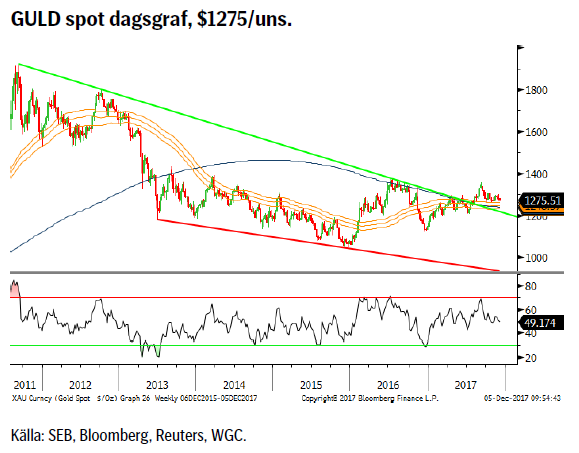 Nästa räntehöjning, från 1,25 – 1,50 %, i USA närmar sig nu med stormsteg något som marknaden mer eller mindre för närvarande har prisat in (98,3 % sannolikhet i skrivande stund). Höjningen bör också medföra att reala Fed funds åter blir positiv, en faktor som bör tynga guldet något. Även den amerikanska senatens godkännande av Trump’s skattepaket tyngde guldet då det förväntas ge ökad tillväxt och en starkare dollar (vilket dock återstår att se).
Nästa räntehöjning, från 1,25 – 1,50 %, i USA närmar sig nu med stormsteg något som marknaden mer eller mindre för närvarande har prisat in (98,3 % sannolikhet i skrivande stund). Höjningen bör också medföra att reala Fed funds åter blir positiv, en faktor som bör tynga guldet något. Även den amerikanska senatens godkännande av Trump’s skattepaket tyngde guldet då det förväntas ge ökad tillväxt och en starkare dollar (vilket dock återstår att se).
Konklusion: Ser ut att avsluta 2017 på den svaga sidan.
OBSERVATIONER
+ Inflöden till guld ETF:er förra veckan.
+ 2017 blir första året med uppgång i efterfrågan från elektroniksektorn sedan 2010.
+ Nordkorea har hettat till igen.
+ Den spekulativa nettopositionen fortsätter att öka (både nya långa & stängda korta positioner).
+ Produktionen föll med 2% under tredje kvartalet.
+ Centralbanker har åter dykt upp som köpare.
+ Efterfrågan på mynt och tackor drevs framför allt av kineser.
+ Amerikanskt skuldtak kommer åter i fokus nästa månad.
+ Ökad geopolitisk risk i Mellanöstern
+ Asiatisk fysisk import fortsatt stark.
+ SPDR guld ETF godkända enligt den nya Shariastandarden.
+ Tekniskt fortsatt kvar över den långa trendlinjen & 55v bandet.
– Amerikansk räntehöjning den 13 december.
– Klubbandet av den amerikanska skattererformen.
– Dåligt gensvar på spänningarna Saudiarabien/Iran.
– Venezuelas konkurs kan tvinga fram försäljningar (om de nu har något guld kvar?).
– Säsongsmönstret talar för fallande guldpris.
– Den spekulativa positioneringen är fortsatt relativt stor varför en nedgång i pris riskerar att tvinga fram stopp försäljningar.
– Realräntorna är i stigande.
– Tekniskt negativt med försäljningar vid varje försök till uppgång.
Tillgängliga certifikat:
BULL GULD X1, X2, X4, X5 & X10 S
BEAR GULD X1, X2, X4, X5 & X10 S
USD/SEK
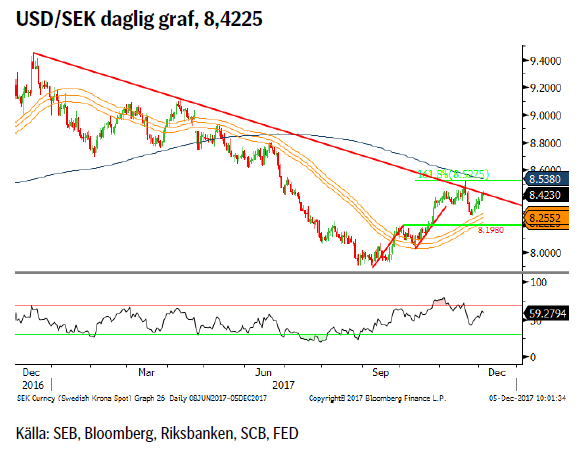 PPM-flöden där majoriteten av de 39,5 miljarderna placeras i utländska tillgångar, godkännandet av det amerikanska skattepaketet samt den kommande amerikanska räntehöjningen (13/12) har eldat på USD/SEK genom både starkare dollar och svagare krona. Även oron på den svenska bostadsmarknaden är på marginalen en SEK negativ faktor (EUR/SEK i skrivande stund åter över 10:an).
PPM-flöden där majoriteten av de 39,5 miljarderna placeras i utländska tillgångar, godkännandet av det amerikanska skattepaketet samt den kommande amerikanska räntehöjningen (13/12) har eldat på USD/SEK genom både starkare dollar och svagare krona. Även oron på den svenska bostadsmarknaden är på marginalen en SEK negativ faktor (EUR/SEK i skrivande stund åter över 10:an).
Konklusion: Återvunnen styrka.
OBSERVATIONER
+ Godkänd amerikansk skattereform
+ 39,5 miljarder SEK i PPM medel på väg.
+ Fed höjer räntan den 13/12 (just nu 98,3 % sannolikhet).
+ Allt fler signaler om fallande lägenhetspriser.
+ Regeringsbildningen i Tyskland kärvar alltjämt.
+ FED har börjat minska sin balansräkning.
+ Kronindex, KIX, har vänt upp från en viktig teknisk nivå.
+ Korträntedifferensen har fortsatt att öka.
+ Tekniskt ligger vi positivt ovanför det stigande 55d mv bandet.
+ Tekniskt skulle ett brott ovanför 8,5280 vara väldigt positivt.
– ECB & Riksbanken är fortsatt duvaktiga.
– Synkroniserad global tillväxt är bra för små exportländer.
– Om Riksbanken snabbare än förväntat blir mer hökaktig vilket vi inte tror sker förrän ECB visar vägen.
– Tekniskt fick vi en negativ veckovändningssignal förra veckan.
– Tekniskt så vände vi ned exakt ifrån huvud/skuldra-målet, 8.5275.
Tillgängliga certifikat:
BULL USDSEK X1 & X4 S
BEAR USDSEK X1 & X4 S
UTVECKLING SENASTE VECKAN SAMT SEDAN ÅRETS BÖRJAN
[box]SEB Veckobrev Veckans råvarukommentar är producerat av SEB:s Commodities Sales desk och publiceras i samarbete och med tillstånd på Råvarumarknaden.se[/box]
KÄLLOR
Bloomberg, Reuters, SEB
VILLKOR
För varje enskilt certifikat/mini future finns Slutliga Villkor som anger de fullständiga villkoren. Slutliga Villkor finns tillgängligt på kurssidan för respektive certifikat/mini future på www.seb.se, Börs & finans, fliken Strukturerade placeringar.
RISKER
En sammanfattning av de risker som är förknippade med Börshandlade certifikat generellt finns i Produktbroschyren för respektive certifikat eller mini future som är tillgängligt på seb.se/cert respektive seb.se/mini. För en fullständig bild av riskerna behöver du ta del av SEB:s offentliggjorda Grundprospekt för Certifikat- och Warrantprogram som är publicerat på www.seb.se/cert respektive seb.se/mini.
DISCLAIMER
Detta marknadsföringsmaterial, framtaget av SEB:s Commodities Sales desk, har upprättats enbart i informationssyfte.
Även om innehållet är baserat på källor som SEB bedömt som tillförlitliga ansvarar SEB inte för fel eller brister i informationen. Den utgör inte oberoende, objektiv investeringsanalys och skyddas därför inte av de bestämmelser som SEB har infört för att förebygga potentiella intressekonflikter. Yttranden från SEB:s Commodities Sales desk kan vara oförenliga med tidigare publicerat material från SEB, då den senare hänvisas uppmanas du att läsa den fullständiga rapporten innan någon åtgärd vidtas.
Dokumentationen utgör inte någon investeringsrådgivning och tillhandahålls till dig utan hänsyn till dina investeringsmål. Du uppmanas att självständigt bedöma och komplettera uppgifterna i denna dokumentation och att basera dina investeringsbeslut på material som bedöms erforderligt. Alla framåtblickande uttalanden, åsikter och förväntningar är föremål för risker, osäkerheter och andra faktorer och kan orsaka att det faktiska resultatet avviker väsentligt från det förväntade. Historisk avkastning är ingen garanti för framtida resultat. Detta dokument utgör inte ett erbjudande att teckna några värdepapper eller andra finansiella instrument. SEB svarar inte för förlust eller skada – direkt eller indirekt, eller av vad slag det vara må – som kan uppkomma till följd av användandet av detta material eller dess innehåll.
Observera att det kan förekomma att SEB, dess ledamöter, dess anställda eller dess moder- och/eller dotterbolag vid olika tillfällen innehar, har innehaft eller kommer att inneha aktier, positioner, rådgivningsuppdrag i samband med corporate finance-transaktioner, investment- eller merchantbanking-uppdrag och/eller lån i de bolag/finansiella instrument som nämns i materialet.
Materialet är avsett för mottagaren, all spridning, distribuering mångfaldigande eller annan användning av detta meddelande får inte ske utan SEB:s medgivande. Materialet riktar sig inte till personer vars medverkan kräver ytterligare prospekt, registrerings- eller andra åtgärder än vad som följer av svensk rätt. Det åligger var och en att iaktta sådana restriktioner. Materialet får inte distribueras i eller till land där distribution kräver ovan nämnda åtgärder eller strider mot reglering i sådant land. Materialet riktar sig således inte till fysiska eller juridiska personer hemmahörande i USA eller i något annat land där publicering eller tillhandahållande av materialet är förbjudet eller strider mot tillämpliga bestämmelser i landet.
Oaktat detta får SEB tillåta omfördelning av materialet till utvald tredje part i enlighet med gällande avtal. Materialet får inte spridas till fysiska eller juridiska personer som är medborgare eller har hemvist i ett land där sådan spridning är otillåten enligt tillämplig lag eller annan bestämmelse.
Skandinaviska Enskilda Banken AB (publ) är ett publikt aktiebolag och står under tillsyn av Finansinspektionen samt de lokala finansiella tillsynsmyndigheter i varje jurisdiktionen där SEB har filial eller dotterbolag.
Analys
Tightening fundamentals – bullish inventories from DOE

The latest weekly report from the US DOE showed a substantial drawdown across key petroleum categories, adding more upside potential to the fundamental picture.

Commercial crude inventories (excl. SPR) fell by 5.8 million barrels, bringing total inventories down to 415.1 million barrels. Now sitting 11% below the five-year seasonal norm and placed in the lowest 2015-2022 range (see picture below).
Product inventories also tightened further last week. Gasoline inventories declined by 2.1 million barrels, with reductions seen in both finished gasoline and blending components. Current gasoline levels are about 3% below the five-year average for this time of year.
Among products, the most notable move came in diesel, where inventories dropped by almost 4.1 million barrels, deepening the deficit to around 20% below seasonal norms – continuing to underscore the persistent supply tightness in diesel markets.
The only area of inventory growth was in propane/propylene, which posted a significant 5.1-million-barrel build and now stands 9% above the five-year average.
Total commercial petroleum inventories (crude plus refined products) declined by 4.2 million barrels on the week, reinforcing the overall tightening of US crude and products.


Analys
Bombs to ”ceasefire” in hours – Brent below $70

A classic case of “buy the rumor, sell the news” played out in oil markets, as Brent crude has dropped sharply – down nearly USD 10 per barrel since yesterday evening – following Iran’s retaliatory strike on a U.S. air base in Qatar. The immediate reaction was: “That was it?” The strike followed a carefully calibrated, non-escalatory playbook, avoiding direct threats to energy infrastructure or disruption of shipping through the Strait of Hormuz – thus calming worst-case fears.

After Monday morning’s sharp spike to USD 81.4 per barrel, triggered by the U.S. bombing of Iranian nuclear facilities, oil prices drifted sideways in anticipation of a potential Iranian response. That response came with advance warning and caused limited physical damage. Early this morning, both the U.S. President and Iranian state media announced a ceasefire, effectively placing a lid on the immediate conflict risk – at least for now.
As a result, Brent crude has now fallen by a total of USD 12 from Monday’s peak, currently trading around USD 69 per barrel.
Looking beyond geopolitics, the market will now shift its focus to the upcoming OPEC+ meeting in early July. Saudi Arabia’s decision to increase output earlier this year – despite falling prices – has drawn renewed attention considering recent developments. Some suggest this was a response to U.S. pressure to offset potential Iranian supply losses.
However, consensus is that the move was driven more by internal OPEC+ dynamics. After years of curbing production to support prices, Riyadh had grown frustrated with quota-busting by several members (notably Kazakhstan). With Saudi Arabia cutting up to 2 million barrels per day – roughly 2% of global supply – returns were diminishing, and the risk of losing market share was rising. The production increase is widely seen as an effort to reassert leadership and restore discipline within the group.
That said, the FT recently stated that, the Saudis remain wary of past missteps. In 2018, Riyadh ramped up output at Trump’s request ahead of Iran sanctions, only to see prices collapse when the U.S. granted broad waivers – triggering oversupply. Officials have reportedly made it clear they don’t intend to repeat that mistake.
The recent visit by President Trump to Saudi Arabia, which included agreements on AI, defense, and nuclear cooperation, suggests a broader strategic alignment. This has fueled speculation about a quiet “pump-for-politics” deal behind recent production moves.
Looking ahead, oil prices have now retraced the entire rally sparked by the June 13 Israel–Iran escalation. This retreat provides more political and policy space for both the U.S. and Saudi Arabia. Specifically, it makes it easier for Riyadh to scale back its three recent production hikes of 411,000 barrels each, potentially returning to more moderate increases of 137,000 barrels for August and September.
In short: with no major loss of Iranian supply to the market, OPEC+ – led by Saudi Arabia – no longer needs to compensate for a disruption that hasn’t materialized, especially not to please the U.S. at the cost of its own market strategy. As the Saudis themselves have signaled, they are unlikely to repeat previous mistakes.
Conclusion: With Brent now in the high USD 60s, buying oil looks fundamentally justified. The geopolitical premium has deflated, but tensions between Israel and Iran remain unresolved – and the risk of missteps and renewed escalation still lingers. In fact, even this morning, reports have emerged of renewed missile fire despite the declared “truce.” The path forward may be calmer – but it is far from stable.
Analys
A muted price reaction. Market looks relaxed, but it is still on edge waiting for what Iran will do

Brent crossed the 80-line this morning but quickly fell back assigning limited probability for Iran choosing to close the Strait of Hormuz. Brent traded in a range of USD 70.56 – 79.04/b last week as the market fluctuated between ”Iran wants a deal” and ”US is about to attack Iran”. At the end of the week though, Donald Trump managed to convince markets (and probably also Iran) that he would make a decision within two weeks. I.e. no imminent attack. Previously when when he has talked about ”making a decision within two weeks” he has often ended up doing nothing in the end. The oil market relaxed as a result and the week ended at USD 77.01/b which is just USD 6/b above the year to date average of USD 71/b.

Brent jumped to USD 81.4/b this morning, the highest since mid-January, but then quickly fell back to a current price of USD 78.2/b which is only up 1.5% versus the close on Friday. As such the market is pricing a fairly low probability that Iran will actually close the Strait of Hormuz. Probably because it will hurt Iranian oil exports as well as the global oil market.
It was however all smoke and mirrors. Deception. The US attacked Iran on Saturday. The attack involved 125 warplanes, submarines and surface warships and 14 bunker buster bombs were dropped on Iranian nuclear sites including Fordow, Natanz and Isfahan. In response the Iranian Parliament voted in support of closing the Strait of Hormuz where some 17 mb of crude and products is transported to the global market every day plus significant volumes of LNG. This is however merely an advise to the Supreme leader Ayatollah Ali Khamenei and the Supreme National Security Council which sits with the final and actual decision.
No supply of oil is lost yet. It is about the risk of Iran closing the Strait of Hormuz or not. So far not a single drop of oil supply has been lost to the global market. The price at the moment is all about the assessed risk of loss of supply. Will Iran choose to choke of the Strait of Hormuz or not? That is the big question. It would be painful for US consumers, for Donald Trump’s voter base, for the global economy but also for Iran and its population which relies on oil exports and income from selling oil out of that Strait as well. As such it is not a no-brainer choice for Iran to close the Strait for oil exports. And looking at the il price this morning it is clear that the oil market doesn’t assign a very high probability of it happening. It is however probably well within the capability of Iran to close the Strait off with rockets, mines, air-drones and possibly sea-drones. Just look at how Ukraine has been able to control and damage the Russian Black Sea fleet.
What to do about the highly enriched uranium which has gone missing? While the US and Israel can celebrate their destruction of Iranian nuclear facilities they are also scratching their heads over what to do with the lost Iranian nuclear material. Iran had 408 kg of highly enriched uranium (IAEA). Almost weapons grade. Enough for some 10 nuclear warheads. It seems to have been transported out of Fordow before the attack this weekend.
The market is still on edge. USD 80-something/b seems sensible while we wait. The oil market reaction to this weekend’s events is very muted so far. The market is still on edge awaiting what Iran will do. Because Iran will do something. But what and when? An oil price of 80-something seems like a sensible level until something do happen.
-

 Nyheter3 veckor sedan
Nyheter3 veckor sedanStor uppsida i Lappland Guldprospekterings aktie enligt analys
-

 Nyheter4 veckor sedan
Nyheter4 veckor sedanBrookfield ska bygga ett AI-datacenter på hela 750 MW i Strängnäs
-

 Nyheter3 veckor sedan
Nyheter3 veckor sedanSilverpriset släpar efter guldets utveckling, har mer uppsida
-

 Nyheter4 veckor sedan
Nyheter4 veckor sedanTradingfirman XTX Markets bygger datacenter i finska Kajana för 1 miljard euro
-

 Nyheter2 veckor sedan
Nyheter2 veckor sedanUppgången i oljepriset planade ut under helgen
-

 Nyheter2 veckor sedan
Nyheter2 veckor sedanLåga elpriser i sommar – men mellersta Sverige får en ökning
-

 Analys2 veckor sedan
Analys2 veckor sedanVery relaxed at USD 75/b. Risk barometer will likely fluctuate to higher levels with Brent into the 80ies or higher coming 2-3 weeks
-

 Nyheter1 vecka sedan
Nyheter1 vecka sedanMahvie Minerals växlar spår – satsar fullt ut på guld



